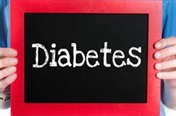
Alternative name: Diabetes mellitus
Diabetes mellitus (or just “diabetes”) is a group of diseases in which the body can’t use and store glucose properly, resulting in high blood glucose concentrations.
Glucose, a form of sugar, is used as fuel for the cells in our bodies. All the carbohydrates we eat get converted to glucose. But, if you have diabetes, your body is unable to manage its glucose levels properly. The glucose backs up in your bloodstream, causing your blood-glucose levels to rise too high. This high glucose level can cause long- and short-term health complications.
To understand diabetes better, it’s worth taking a closer look at the role of insulin – a hormone that’s produced, stored and released by the beta cells in a large gland called the pancreas, which sits behind the stomach. A hormone is a regulatory substance that stimulates specific cells or tissues into action.
The pancreas releases insulin in reaction to the glucose your body makes when you eat food or to the sugar in the food you eat. Insulin helps the glucose to pass from the blood through to the cells (almost like a key unlocking a door to the cells), where the glucose helps the cells to function properly. If there is no insulin available, the glucose cannot pass through the cell membranes. It will remain in the bloodstream, where it can cause damage.
There are a few different types of diabetes:
1. Type 1 diabetes
This type of diabetes occurs due to the immune system destroying the beta cells in the pancreas. People with type 1 diabetes produce very little or no insulin as a result, and need to take insulin in the form of injections to survive. This is why this type of diabetes is also commonly known as “insulin-dependent diabetes”.
It’s believed that type 1 diabetes occurs as a result of an autoimmune reaction in which the body’s defence system attacks and destroys the beta cells. Ongoing studies are trying to determine why this happens. Type 1 diabetes used to be called “juvenile-onset diabetes” as it’s the most common form of diabetes diagnosed in children. But it can occur in adults, too.
Latent autoimmune diabetes of adults (LADA) is a form of type 1 diabetes that occurs in adulthood. This often has a slower course of onset than type 1 diabetes diagnosed in children and is often mistakenly diagnosed as type 2 diabetes.
2. Type 2 diabetes
Type 2 diabetes used to be called “non-insulin-dependent diabetes” or “adult-onset diabetes”, and accounts for at least 90% of all cases of diabetes.
There are at least eight causes of type 2 diabetes, but the most common cause is insulin resistance (when the body’s cells don’t respond well to insulin and can’t easily take up glucose from the blood). This mainly occurs when people are overweight or obese.
The number of individuals with type 2 diabetes has increased over the last few decades, along with the global rise in overweight and obesity. Type 2 diabetes is often (but not always) associated with overweight. It can occur at any age and children as young as five years of age have been diagnosed with this type of diabetes.
Type 2 diabetes can go undetected for years and is often only diagnosed when a complication occurs or when a routine blood or urine glucose test is done. When type 2 diabetes is eventually diagnosed, the pancreas may have already lost 50% of its beta-cell function.
People with type 2 diabetes can often initially manage their condition through regular exercise and a healthy, balanced diet. However, because diabetes can be a progressive disease, most people will require oral medication and/or insulin at a later stage.
3. Gestational diabetes (GDM)
This type of diabetes is characterised by elevated blood-glucose levels (hyperglycaemia) during pregnancy. It develops in one in every 25 pregnancies worldwide and comes with a risk of complications for both mother and baby. Mothers with gestational diabetes usually give birth to very high birth weight babies (4kg or more).
Gestational diabetes usually disappears after pregnancy, but women who have had the condition, as well as their children, are at increased risk of developing type 2 diabetes later in life. Studies have shown that at least 50% of women with a history of gestational diabetes go on to develop type 2 diabetes within 5-10 years after delivery, or sooner.
4. Other types of diabetes
There are a few other types of diabetes. An example is the monogenic diabetes syndromes such as neonatal diabetes and maturity-onset diabetes of the young (MODY), which refers to any of several hereditary forms of diabetes. These are caused by mutations in a gene that disrupts the body’s insulin production.
Other examples are diseases of the exocrine pancreas (e.g. cystic fibrosis) and drug- or chemically induced diabetes (e.g. as a result of HIV/AIDS treatment). All types of diabetes do, however, have one thing in common: an inability to properly manage the body’s insulin/glucose balance.
High levels of blood glucose can damage the tiny blood vessels in the kidneys, heart, eyes and nervous system. This is the reason why diabetes, especially if left untreated, can cause heart disease, stroke, kidney disease, blindness, and nerve damage in the feet (which can ultimately lead to amputation).
Information supplied by Jeannie Berg, diabetes educator and Chairperson of the Diabetes Education Society of South Africa (DESSA), and reviewed by Dr Joel Dave (MBChB PhD FCP Cert Endocrinology), Senior Specialist in the Division of Diabetic Medicine and Endocrinology, University of Cape Town. August 2018.
Read more:




 Publications
Publications
 Partners
Partners















